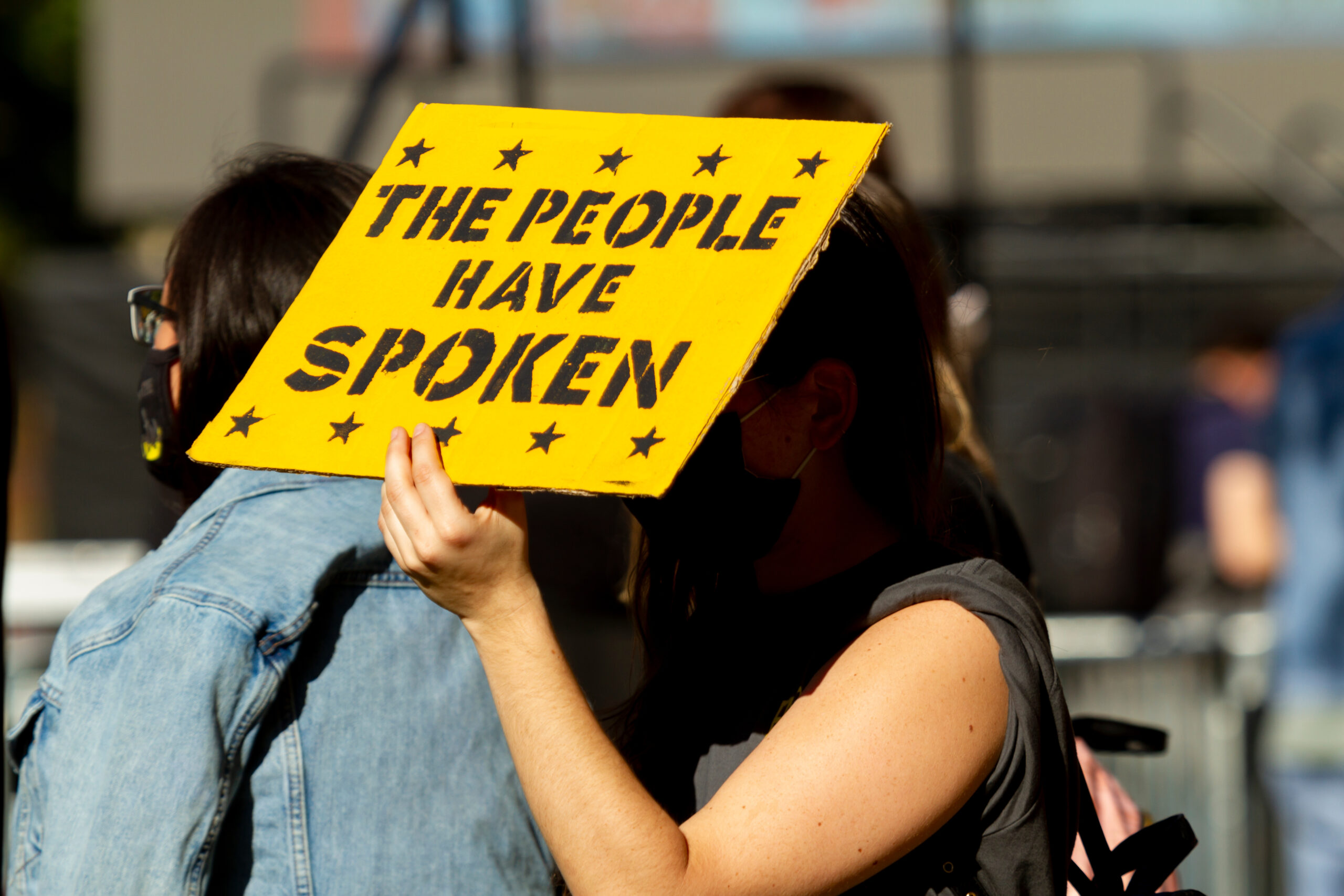
Special Issue: Election Violence
In partnership with Search for Common Ground We are days away from the 2024 U.S. presidential election. The United States faces a real threat of election violence—defined by research featured in this special issue as “coercive force, directed towards electoral actors and/or objects, that occurs in the context of electoral … Read more
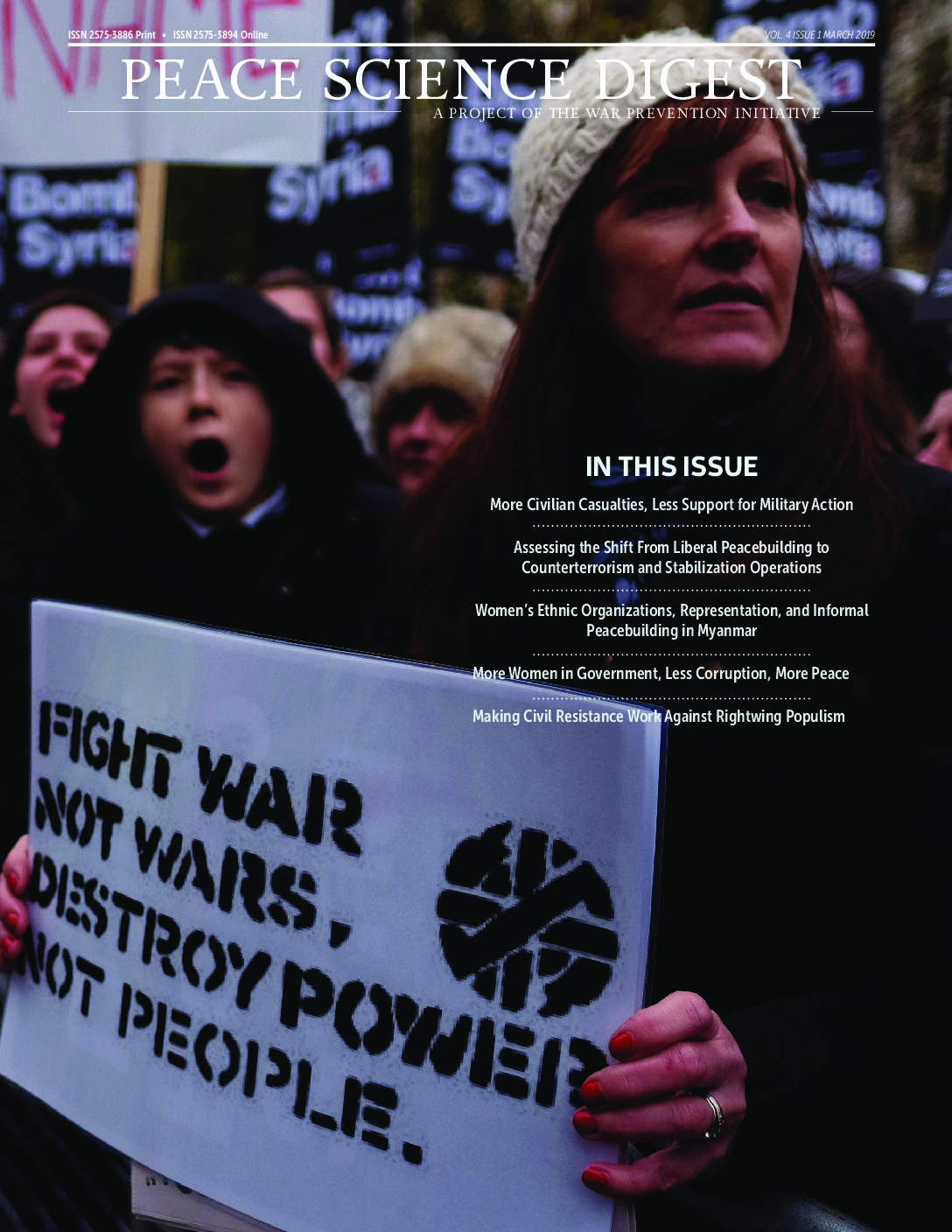
Volume 4, Issue 1
In this issue, each of the articles selected either takes a critical approach to its research question or incorporates a careful perspective on the various racial, ethnic, gender, or other identities at play in its analyses. The first article shows that support for military action decreases when civilian causalities increase. The second criticizes the shift from peacebuilding to stabilization and counterterrorism operations. The third reviews women’s informal participation in the peace process in Myanmar, and broader implications from barriers to their formal participation. The fourth suggests a link between women’s participation in government, reduced levels of corruption, and higher levels of peace. The fifth details strategies for leftist civil resistance movements to confront rightwing counter-protests. The results of this critical approach empower us to see beyond our assumptions, to be surprised by the results of our work, and to view events of the world with a dash of skepticism.
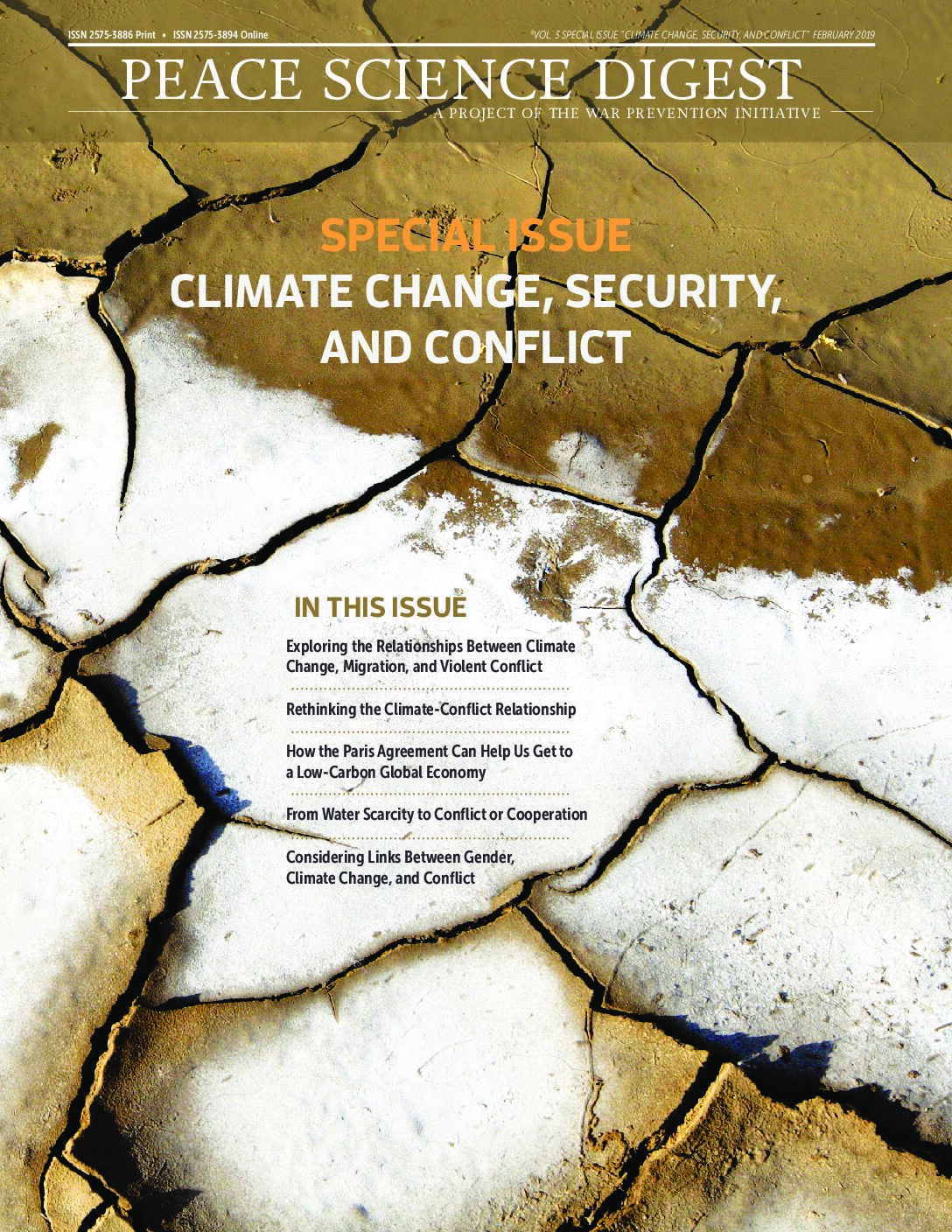
Volume 3, Special Issue: Climate Change, Security, and Conflict
We hope the research discussed in this special issue informs a cascade of activism and policy-making to avert the worst eventualities of climate change and to create a world that is more secure and more just for all of us.
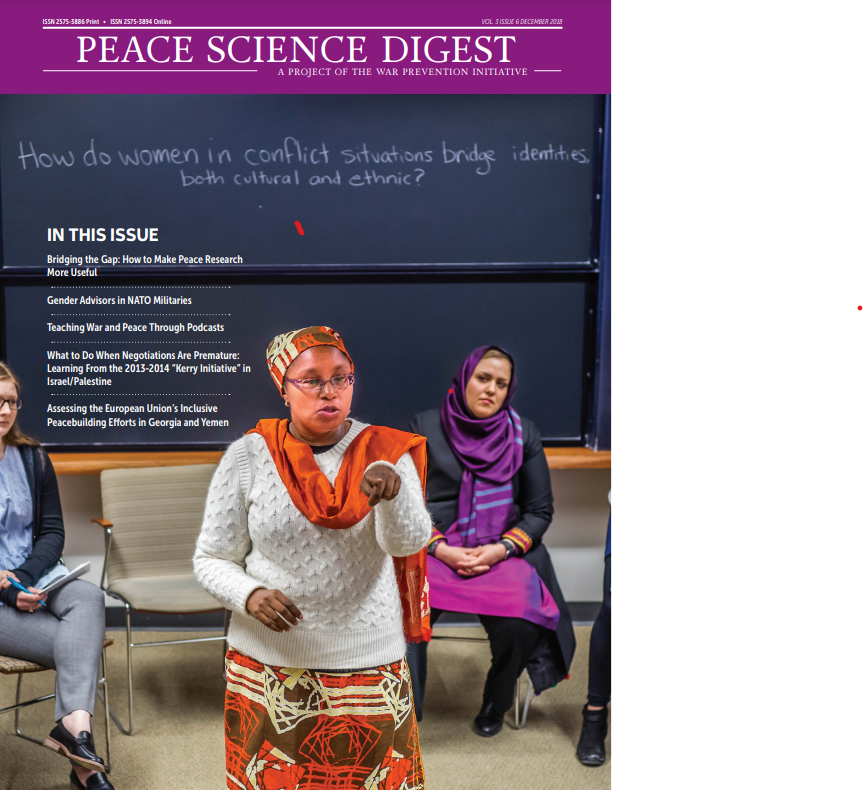
Volume 3, Issue 6
Inside this issue, we start with an article that addresses the rationale for the existence of the Digest: the growing communication gap between practitioner and academic communities, and how addressing this gap can lead to more informed and useful research. Next, we look at research on Gender Advisors in militaries and their role in the United Nations’ Women, Peace and Security (WPS) agenda. The third analysis gives us a look into a new course that uses podcasts to help teach complex topics on peace and war, and how emerging technologies can be a useful tool in peace education. We then turn to a case study analysis on the 2013/14 “Kerry Initiative” in Palestine and Israel, exploring the important and delicate role of third parties during conflict negotiation processes. The last analysis addresses the European Union’s efforts to incorporate inclusive peacebuilding projects in Georgia and Yemen and highlights the important “Whole-of-Society” approach that works to include marginalized communities into the peacebuilding process.
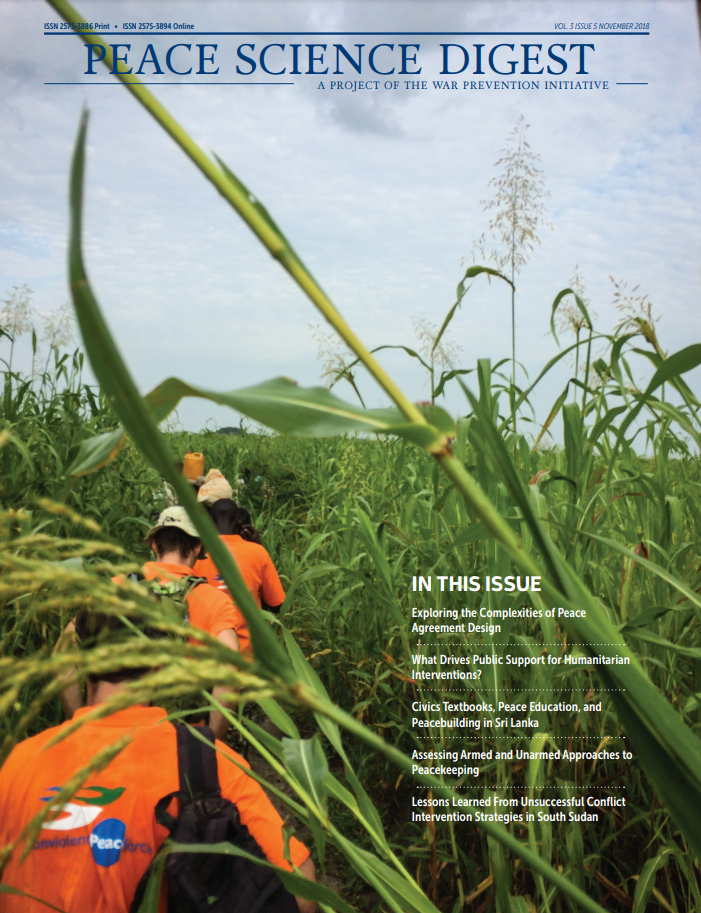
Volume 3, Issue 5
Inside this issue, we examine research analyzing hundreds of civil war peace agreements that concludes that “complex” agreements are not necessarily better at keeping the peace than simpler ones. Next, we take a critical look at research on public support for military interventions and the motivations behind support for interventions conducted for “humanitarian” reasons. Third, through examining civics textbooks in Sri Lanka in the context of global peace education efforts, we consider how specific omissions and emphases in these textbooks have served the government’s goals, while failing to address the injustice and inequality still plaguing post-war Sri Lanka. Next, we discuss research finding that the primary peacekeeping tasks associated with preventing violence and protecting civilians can be effectively undertaken by unarmed peacekeepers, who are, furthermore, often able to address some of the shortcomings of their armed counterparts. Finally, the last analysis reflects on possible reasons for why past attempts at peace in South Sudan have failed, calling for more psycho-sociologically informed conflict interventions in the future.

Special Issue: Gender & Conflict
If there is a silver lining to the current political situation in the U.S., it is the way that polarization can bring latent conflict—in the form of extreme inequality and oppression—to the surface to be addressed. In 2018, one would hope that we would not still be living in a sexist, gender-unequal society (or a racist society, for that matter). But, whereas a few years ago, well-meaning people of all genders might have been able to overlook the ways in which gender (and racial) inequalities still permeate our daily existence, today it is difficult to do so any longer. The courageous revelations of hundreds of women across professions have exposed the insidious ways in which sexual assault and harassment still very much structure power dynamics in the workplace and beyond. Comparisons between world leaders about the size of their nuclear “buttons” have made evident how the desire to look more masculine assists in escalating international conflict. In other words, it is no longer possible to ignore the “work” gender does in politics—from the bedroom to the boardroom to the battlefield.
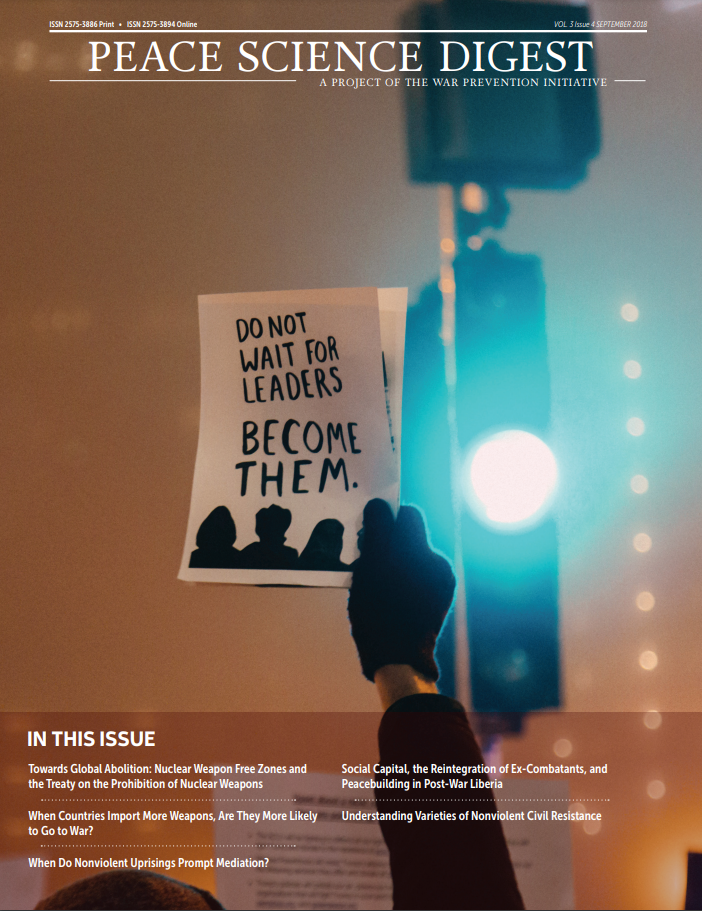
Volume 3, Issue 4
In this issue, we examine research on the successful nuclear weapon free zone treaties that helped pave the way to the 2017 Treaty on the Prohibition of Nuclear Weapons, and how approaching nuclear weapons prohibition through regional stepping stones may be the key to global abolition. Next, by looking at a study on levels of weapons imports, we see a direct relationship between the influx of weapons and the likelihood of a specific classification of countries engaging in civil war. In the third analysis, we learn that less than one in five nonviolent uprisings in the past 45 years has attempted mediation to resolve the conflicts they seek to address. It turns out that higher risks and costs associated with a nonviolent uprising—either the presence of radical flanks or high levels of state repression—are closely related to mediation attempts. Next, we are taken to post-war Liberia where we explore the role of trust, norms, and social networks play in the ability of former combatants to reintegrate into society. The research highlights additional perspectives on the devastating toll war plays on individuals and societies, even after the fighting ends. Our last analysis focuses on why different organizations in the same movement choose the specific nonviolent tactics they do, resulting in a consideration of resource availability, interdependence, and strategic decision-making.

Volume 3, Issue 3
Inside this issue, you will find analysis of research highlighting the importance of one of the Digest’s primary goals: making academic research more accessible and relevant to those beyond the academic community. Four additional analyses look at the relationship between people’s beliefs on masculinity and honor, on the one hand, and their attitudes towards aggressive policies and war, on the other; the complex attitudes of people in a post-conflict setting “after the smoke clears” by looking at how different conflict narratives contribute to reconciliation; how to influence nonstate actors to comply with humanitarian norms, laws, and treaties; and, lastly, we analyze a study examining the methods by which liberal democracies create and sustain militarism and hence enable war.
Volume 3, Issue 2
In this issue of the Peace Science Digest, we present research highlighting the everyday violence and coping mechanisms of Afghan civilians amidst nearly 40 years of war. Next, we look at the important work of Christian Peacemaker Teams in Palestine/Israel and the tension that exists between their dual accompaniment and solidarity roles in the West Bank. We then turn to the significance of a largely overlooked distinction between borrowing money to fund war versus imposing a war tax—and how the latter vastly reduces public support for war. In the fourth analysis, we examine a study that looks back on North Korean-Western relations to reveal interesting conclusions on how the parties react to triggers and provocations. Finally, we look at research on the Arab Spring, and why civil resistance movements in some countries were more successful than in others.
Volume 2, Issue 6
In this issue of the Peace Science Digest, you will find research highlighting the negative effects of military spending on a country’s long-term economic growth—contrary to many beliefs, war is not good for the economy. Next, we look at how ad-hoc military intervention increases the likelihood of retaliatory terror attacks, showing how current military strategies are actually making us less secure. We then turn to the role of social media in violent conflict, and how this new age of communication is changing how conflicts are conducted and how conflict actors communicate. In the fourth analysis, we look at how political leaders consider initiating conflicts abroad to distract from domestic problems. Finally, we look at Peace Journalism at a contribution aimed at making Peace Journalism more relevant.
Special Issue: Nuclear Weapons
Inside this issue, we analyze research on the negligent dismissal of environmental and health considerations during the world’s race to develop nuclear weapons. The second analysis examines how the perceived legitimacy, power, and language of certain people can influence thinking and policy on nuclear disarmament efforts. The third analysis examines how gender and Western domination of knowledge shape nuclear discourse. In the fourth analysis, we highlight the importance of devaluing nuclear weapons not only as material, but as social objects. Finally, we examine empirical research that considers U.S. proximity and power as the main contributor to North Korea’s nuclear ambitions.
